Highly Recommended Award
Our Highly Recommended designation is earned by products offering extraordinary value or performance in their price class.
- Bright image
- RGB laser light source
- 48Gbps HDMI 2.1
- Dynamic tone mapping
- Optical zoom
- Great BT.2020 gamut coverage
- 3D support
- Good sound performance
- Built in Subwoofer
- Dolby Vision and HDR10+ support
- Bulky stand
- Some rainbow effect
- Low native contrast
The Hisense C2 Ultra is the flagship model of Hisense’s TriChroma Laser mini projector lineup and their second officially Designed for Xbox projector, following the highly popular and well-performing PX3 Pro Laser UST, which Projector Central reviewed in September 2024. Capable of delivering suitable gaming performance and big-screen cinematic immersion, the Hisense C2 Ultra is designed to meet the needs of both gamers and movie enthusiasts alike.
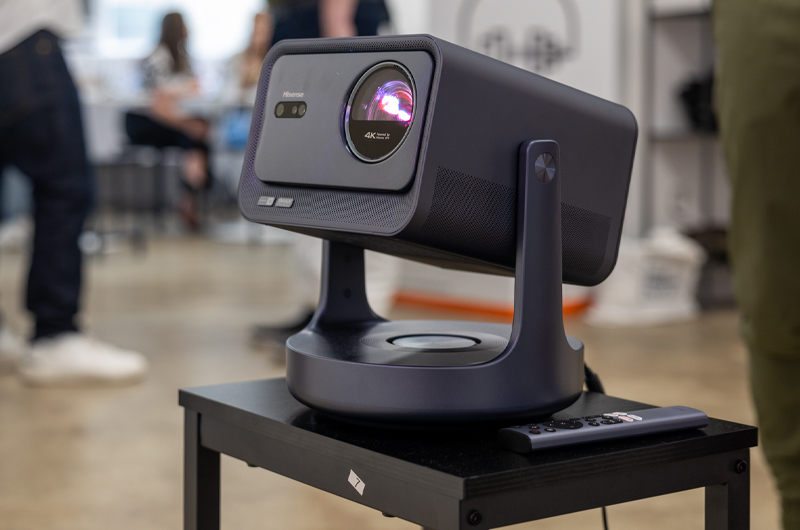
In late 2024, Hisense released its new lineup of C2 TriChroma Laser mini projectors, offering users a range of price points. At the top of this collection stands the C2 Ultra, priced at $2,499.99 on Hisense's website.
The C2 Ultra boasts an impressive set of features, including an RGB laser light source, a built-in subwoofer, and a Designed for Xbox certification. It caters to users looking for an immersive gaming and movie-watching experience while remaining competitively priced within the lifestyle projector segment.
Features
The Hisense C2 Ultra, released in late 2024 with an MSRP of $2,999.99, is the flagship model within Hisense's C2 line of TriChroma laser mini projectors, positioned in the lifestyle projector category. It offers viewers a compact projector suitable for both movies and gaming. Featuring the now-common gimbal stand design, the C2 Ultra takes a slightly different approach by incorporating a small yet capable 20W subwoofer into the base of the stand. This addition enhances lower-frequency audio performance when using the built-in 20W JBL stereo speakers.
The C2 Ultra has a listed brightness specification of 3,000 ANSI lumens. However, our testing showed that it did not fully meet this specification, measuring 2,779 ANSI lumens in Dynamic picture mode with the Brightness Enhancer set to its Ultra setting. With the Brightness Enhancer in the Low setting, it measured 2,593 ANSI lumens in Dynamic picture mode, while Dynamic with this setting enabled measured 2,466 ANSI lumens. This falls 17.7% below Hisense's specification but remains within the allowable 20% tolerance defined by ISO 21118. When using the Brightness Enhancer Ultra setting, the measurement was 7.36% below the stated specification.
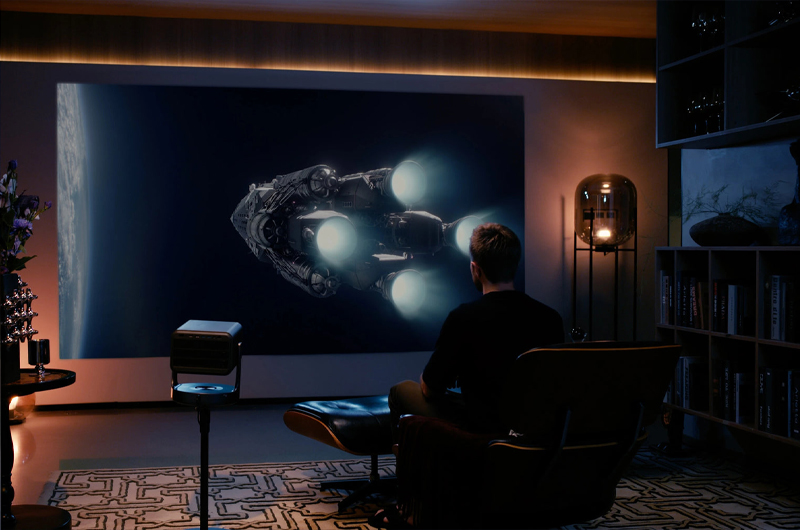
The C2 Ultra features Hisense's pure RGB triple-laser light engine, employing an LPU engine, which provides more than 25,000 hours of lifespan. With 28 total laser chips, it delivers precise and accurate color reproduction along with impressive gamut coverage. Hisense lists a specification of 110% BT.2020 coverage. Our measurements, however, recorded 93.68% in xy and 96.52% in uv—excellent results, as expected from a pure RGB laser projector. Additionally, the C2 Ultra achieves full 100% coverage of both Rec.709 and P3 in both xy and uv. Notably, it exhibits minimal laser speckle on higher-gain screens, an important factor given that RGB lasers can sometimes produce pronounced speckle.
The C2 Ultra employs TI's 0.47-inch DMD DLP chip with a native 1080p resolution, utilizing four-phase pixel shifting to achieve a 4K UHD resolution of 3840x2160 pixels. The resulting image is exceptionally sharp, although it does exhibit a mild rainbow effect, which may be a consideration for viewers sensitive to this phenomenon.
An optical zoom feature is included—a welcome addition, as it is relatively uncommon in lifestyle projectors. The C2 Ultra offers a throw ratio of 0.9 to 1.5:1, allowing placement as close as 4.2 feet for a 65-inch diagonal image, up to 32 feet for a 300-inch projection. However, due to its actual light output, users may find it ideal to stick with more modest screen sizes. A digital zoom function is also available to further reduce the image size once the optical zoom range is maxed out.
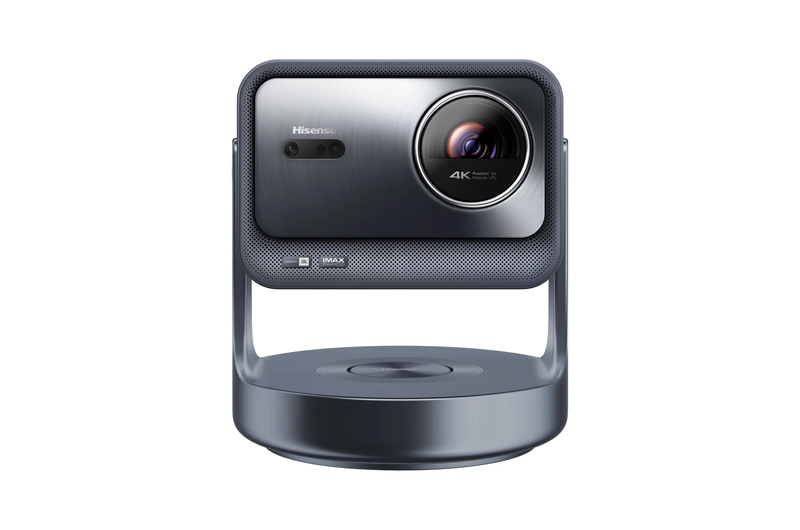
Thanks to its integrated gimbal stand and optical zoom, the C2 Ultra offers flexible placement options. With the dimensions of 9.7 x 11.3 x 9.7 inches (WHD), and a total weight of 13.9 lbs. the C2 Ultra can be placed in several locations. For more challenging installations, features such as auto keystone correction, manual four-point keystone adjustment, and trapezoidal correction are provided. Additional conveniences include auto focus, smart object avoidance, wall color adaptation, and laser eye protection. As always, it's recommended to avoid using keystone correction whenever possible to maintain image integrity, though these features can be useful for temporary setups. To determine the appropriate throw distance for your desired screen size, you can use the ProjectorCentral Hisense C2 Ultra projection calculator.
The C2 Ultra supports some of the latest formats for movie viewing, including Dolby Vision, HDR10+, and IMAX Enhanced. Additionally, it features built-in support for Dynamic Tone Mapping (DTM) for HDR10 content. Thanks to its well-implemented DTM, the C2 Ultra delivers solid HDR performance. While some clipping was present in various content, the overall image remained pleasing. Unfortunately, its native contrast was somewhat disappointing, measuring approximately 1,600:1. Despite this shortcoming, the projected image was still quite good and immersive.
The C2 Ultra features the VIDAA smart platform, which boasts a modern, sleek interface. The user experience is smooth and responsive, offering everything needed to start enjoying big-screen content right out of the box. Preloaded with popular streaming apps like Netflix, Prime Video, YouTube, and Disney+, the VIDAA platform correctly detects and displays the appropriate dynamic range for both SDR and HDR content. Additionally, the VIDAA App Store allows users to download other apps such as MAX, Crunchyroll, and more. Other notable features include Amazon Alexa, VIDAA Voice, AirPlay 2, and Miracast, providing voice assistant integration and screen mirroring capabilities.
One of the C2 Ultra's standout features is its audio performance, thanks to its 2.1 audio configuration, which includes two 10W JBL speakers and a 20W subwoofer housed within the base of the gimbal stand. This setup delivers a full-bodied sound that many users will find more than sufficient for most situations. While it cannot truly match the quality a dedicated sound system like an AVR/AVP or a high-end soundbar, the C2 Ultra's built-in audio is impressive. Additionally, it supports eARC, allowing lossless audio to be passed through to a more substantial external sound system if desired. However, one thing to note is that the base of the gimbal stand is bulkier than those found on other lifestyle projectors due to the subwoofer being integrated into the base.
The C2 Ultra is also Designed for Xbox certified, meaning it meets Xbox's branding and technical standards for optimal compatibility with Xbox consoles. This certification, awarded after rigorous testing by Team Xbox, assures buyers that the product was developed in collaboration with Xbox to provide the best possible gaming experience. The C2 Ultra achieves an input latency of 9ms when running at 240Hz with a 1080p resolution, making it capable of delivering a responsive gaming experience. However, since reaching 240Hz is not feasible for console gamers, the C2 Ultra is better suited for casual gaming, as latency at 120Hz is measured at 21ms.
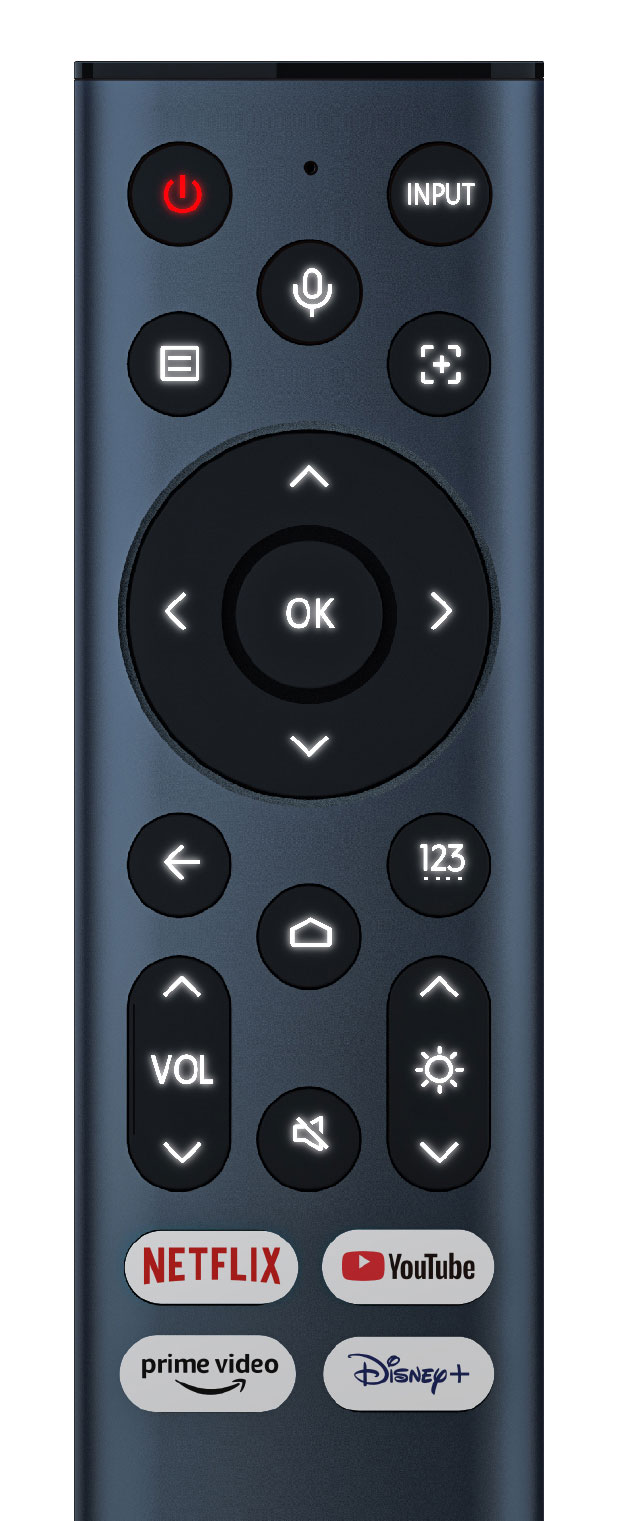
The C2 Ultra's I/O provides users with two HDMI inputs: one is a full HDMI 2.1 port with 12Gbps per lane, totaling 48Gbps bandwidth, and supports ALLM (Auto Low Latency Mode). The second HDMI input is HDMI 2.0 with eARC support. Additionally, there are two USB ports—one USB 3.0 and one USB 2.0—both supporting media playback. Other available ports include an RJ45 Ethernet port, an SPDIF optical port, and a 3.5mm audio output. The C2 Ultra also supports Wi-Fi 6E, Bluetooth, and 3D functionality.
The included backlit remote is responsive and operates via Bluetooth. It offers quick access to popular streaming apps such as Netflix, YouTube, Prime Video, and Disney+. Dedicated buttons for input switching, voice assistants, laser brightness, and focus adjustment are also included, along with standard navigation controls.
Performance
The C2 Ultra provides users with a total of 21 picture modes. There are seven options for SDR, eight for HDR10, three for Dolby Vision, and three for HDR10+. With this wide range of choices, users are sure to find a picture mode that suits their preferences.
The available SDR picture modes include Standard, Enhanced (ACR), Filmmaker, Cinema Day, Cinema Night, Dynamic, and Sports. HDR picture modes follow the same naming conventions with an "HDR" prefix added, along with the inclusion of IMAX Enhanced. The Enhanced (ACR) picture mode, available for both SDR and HDR, automatically adjusts both image and sound, as these settings are linked. Notably, this mode appears to retain the characteristics of the previously selected picture mode. For example, if a user was viewing Standard mode before switching to Enhanced (ACR), the latter will resemble Standard. Likewise, if Filmmaker Mode was previously selected, Enhanced (ACR) will adopt its appearance.
Dolby Vision offers three picture modes: Dolby Vision Bright, Dolby Vision Dark, and Custom. HDR10+ provides access to Standard, Theater, and Dynamic picture modes.
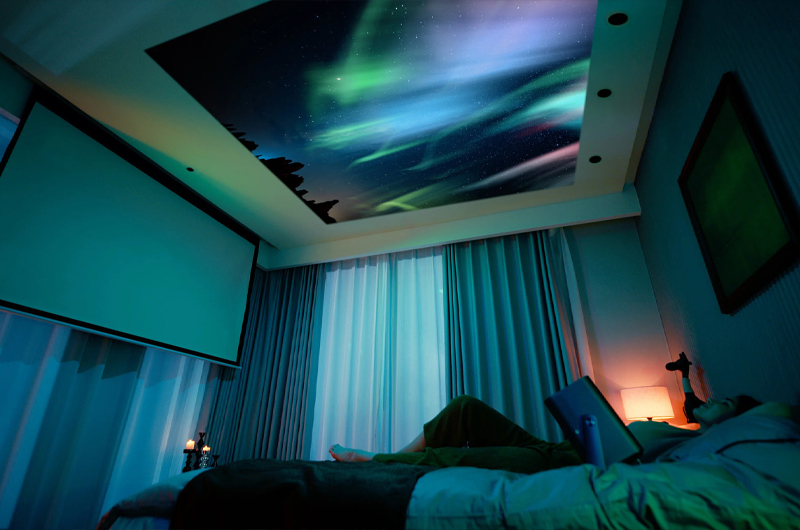
SDR and HDR picture modes that share the same name, such as Filmmaker or Standard, allow independent adjustments for all settings except white balance. This works well, as white balance settings carry over accurately. Additionally, since the laser brightness level can be set independently for SDR and HDR, users can configure the C2 Ultra to provide a brighter HDR picture without manually switching picture modes, as the projector correctly recalls the appropriate laser brightness based on the content's dynamic range.
The C2 Ultra includes a comprehensive suite of calibration controls, allowing adjustments to brightness, contrast, saturation, and sharpness. Advanced calibration features include both 2-point and 20-point white balance adjustments, a 20-point gamma calibration, and a full Color Management System (CMS). The gamma options—1.8, 2.0, 2.2, 2.4, 2.6, and BT.1886—accurately track according to their respective settings.
Out of the box (OOTB), the image quality of the C2 Ultra was generally good. The image had a slightly cooler tone, which some users may prefer. Additionally, I was pleased to see that the Auto color space setting functioned properly, selecting the correct color space based on the content being viewed.
The picture modes use predefined settings, including varying laser brightness levels, different color spaces such as BT.2020, adjustments to sharpness and contrast, and varying color temperatures. Users who prioritize accuracy would ideally opt for Filmmaker, Cinema Day, or Cinema Night mode and select the Warm 1 color temperature.
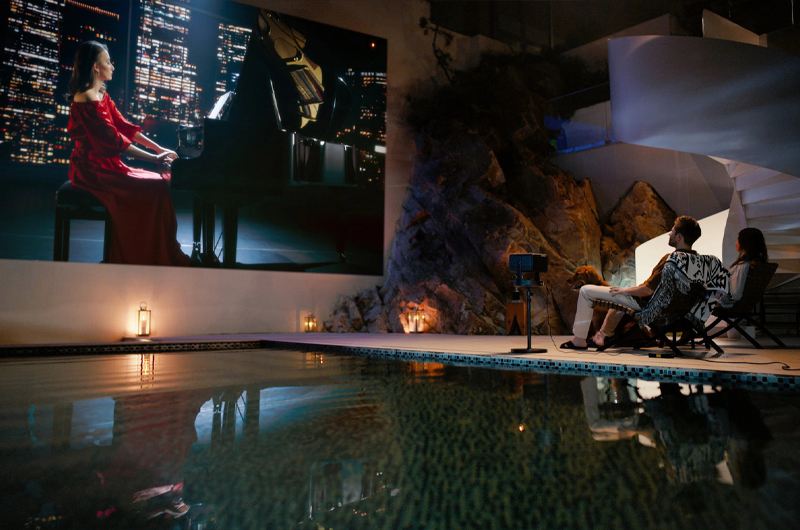
I calibrated the C2 Ultra with Calman Ultimate calibration software from Portrait Displays, a 1nm Qalif Spectro, Colorimetry Research CR-250 Spectroradiometer, Colorimetry Research CR-100 Colorimeter, and a Murideo 8K Seven Generator. The C2 Ultra was calibrated to a 100-inch diagonal screen size on a Stewart Filmscreen StudioTek 130 G4 projection screen. I ran my normal measurements to confirm what I saw in OOTB viewing prior to calibration.
The pre-calibration measurements for the C2 Ultra showed lower average dE errors OOTB using the Filmmaker picture mode. (DeltaE is the metric used to determine visible errors. It has been determined that anything over a dE of 3 is visible, anything over 2.3 is a just noticeable difference for trained eyes and anything below 2.3 should ideally not be seen to the eye.) Average readings for SDR were in the range of approximately 1.6dE to 3.1, with maximum errors reaching up to 6.7dE. Grayscale averages were 3.1dE with a max of 6.3dE, 10% saturation sweeps averaged 1.6dE with a Max of 3.8dE, and large-scale Color Checker averaged 1.7dE with a max of 6.7dE. HDR averaged 1.4dE for its grayscale tracking due to utilizing Filmmaker mode which was already calibrated for SDR and shared the white balance between the two.
The C2 Ultra's gamut coverage measured 93.68% xy and 96.52% uv for BT.2020, while P3 coverage measured 99.76% xy and 99.81% uv.
I targeted the industry-standard D65 neutral gray white point using the Gain controls, and employed the full CMS controls for calibration.
The post-calibration DeltaE errors improved for both SDR and HDR. In Filmmaker picture mode for SDR, the final grayscale average was 1dE, with a maximum of 1.9 dE. A large 150+ patch Color Checker, which tests swatches representing different skin tones, blue sky, etc., measured an average of 1.2dE with a maximum of 3.9 dE. Saturation sweeps at 10% increments showed an average of 0.9dE and a maximum of 2.8dE. Post-calibration HDR results, using the HDR Theater picture mode, showed an average of 1.4dE for grayscale and 5.7dE for gamut saturation sweeps for BT.2020.dE.
The device I used for reviewing content post calibration was an AppleTV 4K.
1080p/SDR Viewing. I started watching SDR content and chose Waterworld via Apple TV 4K. The C2 rendered the movie well, displaying good detail and accurate skin tones. The skies were free of posterization or banding, with clean and smooth gradients. The C2 Ultra performs well with SDR content, and the sound quality was also good, providing sufficient audio output. The C2 Ultra provided a pleasing and immersive experience.

4K/HDR10+ Viewing. The next selection was Rings of Power Season 1, Episode 5, viewed in HDR10+ via Apple TV 4K. The scene I focused on was the orcs' raid on the village.
The first thing that stood out was the C2 Ultra's low native contrast, which was most noticeable when Arondir stood on the rooftop looking into the distance. When using Adaptive Contrast, the effect varied—Low produced a more pleasing image, while Medium crushed details, and High raised the black floor too much.
Additionally, the torches in the distance exhibited a noticeable rainbow effect. This issue wasn't limited to smaller highlights; it extended to the lanterns inside the homes when Theo informed the villagers of the orcs' arrival. While the image itself didn't look bad—the fire had nice saturation without excessive clipping—the scene wasn't rendered as I would have liked.
4K/HDR10 Viewing. The next movie I decided to watch was Deadpool & Wolverine in HDR via Apple TV 4K. The scene I focused on was when Cassandra speaks to Wolverine at the gravestones. This scene looked great, delivering a sharp and detailed image with well-balanced skin tones.

As the scene progressed to the moment when Deadpool uses Juggernaut's helmet, everything remained visually impressive. Deadpool's suit displayed rich color without excessive oversaturation.
Later, when Deadpool and Wolverine emerged through the portal and met Paradox, followed by Cassandra's arrival, the skin tones of both Paradox and Cassandra were well-rendered. Finally, when the Deadpool Corps arrived, the C2 Ultra accurately captured the subtle variations in the colors of their suits.
Ultimately, the C2 Ultra performed exceptionally well with this movie.
The last movie I decided to watch was Kong: Skull Island in HDR via Apple TV 4K. I viewed multiple scenes several times, both with and without Dynamic Tone Mapping (DTM). The image generally looked good regardless of whether DTM was enabled, but the difference in highlight brightness was quite noticeable when it was active.
Want more articles like this?
Subscribe to get ProjectorCentral's comprehensive coverage of projector tech delivered directly to your inbox.
For instance, in the scene where the team lifts off from the carrier in their helicopters to fly to the island, the highlights were significantly brighter with DTM enabled. As a result, the sky and clouds appeared somewhat clipped, with the subtle variations in the sky blending together. Additionally, DTM raised the overall Average Picture Level (APL), making the entire image appear brighter.

Without DTM, the scenes still looked good, though some of the visual "pop" was lost. However, the image appeared more balanced overall, preserving a good amount of detail at the cost of reduced highlight brightness. The C2 Ultra displayed impressive color saturation, particularly during the scene where Kong attacks the helicopters. The sky and fire at the end of the attack appeared richly saturated, and the image remained sharp and highly detailed.
Conclusion
The C2 Ultra is a highly versatile projector that can be used in both traditional home theater setups and as a lifestyle projector for temporary events. It delivers good brightness and surprisingly strong audio performance, making it a well-rounded choice. Additionally, it offers good gaming performance for more casual gaming sessions. The C2 Ultra features a sleek and modern user interface powered by the VIDAA smart platform, which feels mature and refined—a welcome departure from the more commonly seen Google TV UI on today's lifestyle projectors.
That said, the C2 Ultra is somewhat bulky compared to other lifestyle projectors, primarily due to its large stand base. This reduces its portability, making it less convenient to move from one location to another—a key feature many seek in lifestyle projectors. However, this may not be a concern for users who plan to keep it in a fixed setup.
The C2 Ultra achieves an input latency of 9ms when running at 240Hz with a 1080p resolution, making it capable of delivering a responsive gaming experience. However, since reaching 240Hz is not feasible for console gamers, the C2 Ultra is better suited for casual gaming, as latency at 120Hz is measured at 21ms.
The only other area where the C2 Ultra could improve is its contrast, which is relatively low. This becomes noticeable to viewers accustomed to higher contrast ratios.
Overall, the C2 Ultra is a strong performer with a solid feature set. It offers good brightness, excellent color gamut coverage, optical zoom, dynamic tone mapping, solid audio quality (thanks to the built-in subwoofer), and a smart platform that enhances the user experience—all while delivering excellent color accuracy.
With many strong options available in the lifestyle projector category, the C2 Ultra stands out as a compelling choice. It's certainly worth considering for anyone in the market for a lifestyle projector.
Measurements
Brightness. The Hisense C2 Ultra is rated for 3,000 ANSI lumens. The brightest picture mode is Dynamic using the Ultra setting in Brightness Enhancer which measured 2,779 ANSI lumens using the 9-point averaged measurement defined in the ISO and recently retired ANSI standards. That result is approx. 7.36% below Hisense's listed specification. However, this picture mode is not suitable for viewing content due to its heavy green bias. Lumen measurement without Brightness Enhancer enabled measured 2,466 ANSI Lumens which is approx. 17.7% below Hisense's listed specification, though within the 20% allowable tolerance of the ISO21118 specification.
Hisense C2 Ultra ANSI Lumens
| SDR | ANSI Lumens |
|---|---|
| Dynamic (BE Low) | 2,593 |
| Dynamic (BE Ultra) | 2,779 |
| Standard | 2,145 |
| Enhanced (ACR) | 2,145 |
| Filmmaker | 1,528 |
| Cinema Day | 2,244 |
| Cinema Night | 2,244 |
| Dynamic | 2,466 |
| Sports | 2,194 |
| HDR | ANSI Lumens |
| HDR Standard | 2,170 |
| Enhanced (ACR) | 2,194 |
| Filmmaker | 2,219 |
| IMAX Cinema | 2,268 |
| HDR Day | 2,269 |
| HDR Night | 2,219 |
| HDR Dynamic | 2,071 |
| HDR Sports | 2,170 |
Zoom Lens Light Loss. The C2 Ultra's light loss when shifting from the widest zoom position to its longest telephoto position was 7.8%.
Brightness Uniformity. The Hisense C2 Ultra projecting a 100-inch diagonal image resulted in measured brightness uniformity of 90% in wide-angle zoom and 89% in telephoto zoom. The brightest portion of the screen was the middle center with the dimmest being the right top. The difference in brightness on a full white screen was not noticeable.
Fan Noise. Using Room EQ Wizard software and a Umik-1 microphone, my theater room ambient noise floor is 33.3 dBA. The C2 Ultra measured at the following dB in the following laser power settings at a distance of 3 feet.
Laser Brightness 10
Rear: 36.0 dbA
Left: 34.6 dbA
Right: 34.8 dbA
Front: 34.8 dbA
Input Lag. Input lag measurements were done in Game Mode and High Refresh Rate Mode, using a Murideo Generator Seven-8K signal generator and optical sensor. The measurements were:
Game Mode
1080p/60Hz = 38ms
1080p/240Hz = 12ms
4K/60Hz = 38ms
4K/120Hz = 48 ms
High Refresh Rate + DLP Turbo Mode
1080p/60hz = 33ms
1080p/120hz = 21ms
1080p/240hz = 9ms
4k/60hz = 33ms
4k/120hz = 21ms
Connections
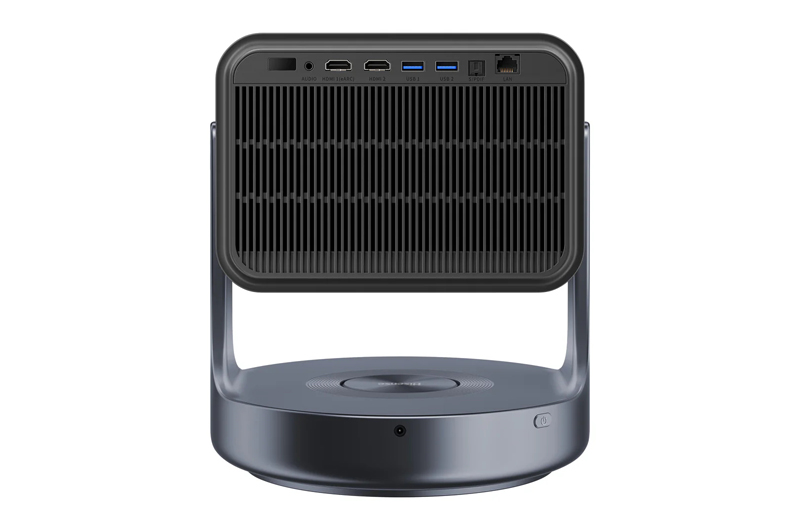
- HDMI 2.1 (x1; HDCP 2.3; ALLM; 48Gbps FRL: 12G@4L)
- HDMI 2.0 (x1; HDCP 2.3; eARC HDMI 1)
- RJ45 LAN 100 base Tx
- USB 3.0 Type A (power delivery; media playback)
- USB 2.0 Type A (power delivery; media playback)
- SPDIF optical audio
- 3.5mm headphone jack
Final Settings
Calibrated image settings from any third-party do not account for the significant potential for sample-to-sample variation, nor the different screen sizes and materials, lighting, lamp usage, or other environmental factors that can affect image quality. Projectors should always be calibrated in the user's own space and tuned for the expected viewing conditions. However, the settings provided here may be a helpful starting point for some. Always record your current settings before making adjustments so you can return to them as desired. Refer to the Performance section for some context for each calibration.
SDR
Picture Mode Settings
Picture Mode: Filmmaker
Laser Luminance Level: 4
Brightness: 50
Contrast: 65
Color Saturation: 50
Sharpness: 9
Advanced Settings
Brightness Enhancer: Off
Light Sensor: Off
Adaptive Contrast: Low
High Dynamic: Off
Dark Detail: Off
HDR Enhancer: Off
Gamma Adjustment: 2.4
Gamma Calibration: Default values
Color
Color Temperature: Warm 1
Color Gamut: Auto
Color Tuner
| Color | Hue | Saturation | Brightness |
|---|---|---|---|
| Red | 0 | 1 | 0 |
| Green | 0 | 0 | 0 |
| Blue | 0 | 0 | 1 |
| Yellow | -1 | 0 | 0 |
| Cyan | 0 | 0 | 0 |
| Magenta | 1 | 0 | 1 |
| Flesh Tone | 0 | 0 | 0 |
White Balance
2 Point
R-Offset: 0
G-Offset: 0
B-Offset: 0
R-Gain: -1
G-Gain: 0
B-Gain: -3
Clarity
Noise Reduction: Off
Digital Noise Reduction: Off
Gradient: Low
HDR
Picture Mode Settings
Picture Mode: Filmmaker
Laser Luminance Level: 10
Brightness: 50
Contrast: 80
Color Saturation: 50
Sharpness: 9
Advanced Settings
Brightness Enhancer: Off
Light Sensor: Off
Adaptive Contrast: Low
High Dynamic: Off (User Preference)
Dynamic Tone Mapping: On
Dark Detail: Off
HDR Enhancer: Off
Gamma Adjustment: N/A
Gamma Calibration: Default values
Color
Color Temperature: Warm 1
Color Gamut: Auto
Color Tuner
| Color | Hue | Saturation | Brightness |
|---|---|---|---|
| Red | 1 | 5 | 4 |
| Green | 2 | 8 | 4 |
| Blue | 1 | 2 | 1 |
| Yellow | 0 | 4 | 5 |
| Cyan | 1 | 10 | 5 |
| Magenta | 0 | 6 | 4 |
| Flesh Tone | 0 | 0 | 0 |
White Balance
2 Point
R-Offset: 0
G-Offset: 0
B-Offset: 0
R-Gain: -1
G-Gain: 0
B-Gain: -3
Clarity
Noise Reduction: Off
Digital Noise Reduction: Off
Gradient: Low
Super Resolution: On
For more detailed specifications and connections, check out our Hisense C2 Ultra projector page.
To buy this projector, use Where to Buy online, or get a price quote by email direct from Projector Central authorized dealers using our E-Z Quote tool.







